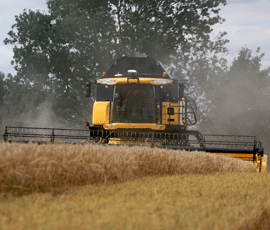Concerns over malting barley nitrogen levels

Combines have made good progress since the weekend with the first wheats being cut, but there were concerns over high nitrogen contents in some malting barleys crops.
In Kent, wheat started to be delivered into GH Grain, Wingham on Tuesday (26 July), said grain marketing director Charles Roberts. Quality indications were good so far, with Gallant milling wheat testing at 82kg/hl and 12-13.5% protein.
“We’ve had quite a lot of oilseed rape in; quality is very good and yields are slightly above average.” But winter barley had some high nitrogen levels, and yields ranged from very good to very mediocre, he added.
Guy Smith was also combining winter wheat at Wigborowick Farm, St Osyth, Essex; his earliest start since 1976. By Tuesday he had cut 4ha of Cordiale, which had yielded about average, with 11.2% protein, 385 Hagberg and 82kg/hl.
“Although ear counts are low, the grain size and density is very good,” he said. “It’s also got a low DON (mycotoxin level), which is important, given the rain we’ve had in the past six weeks. It’s starting to get that grey, washed-out look already, which is worrying.”
Further north, drizzly conditions brought combines to a halt on Tuesday near Aylsham, Norfolk, and very few crops were coming into store dry, said Andrew Dewing, chief executive at Dewing Grain. “Most are coming in at between 15.3% and 17% moisture – the better-equipped farmers and central store members are cracking on, while others are waiting for moisture levels to drop.”
Farmers in the area had cut about half their winter barley, and nitrogen contents were extremely variable, even within individual samples. Only about 70% of samples were passing the malting grade, and with lower-than-average yields, and potentially problematic spring barley due to regrowth, malting barley could be very tight this year, he added.
Showers were also frustrating farmers in Wiltshire, where winter barley and oilseed rape harvest was less than halfway through, said Nick Brown, store manager at Wiltshire Grain. Barley yields were about average, and rapeseed yields were better than expected, he said.
Further west, Matthew Collins was pleased with Saffron winter barley at Chy-Vellan Farm, Marazion, Cornwall, with yields of over 7.4t/ha (3t/acre) at 14.8% moisture. “We were quite surprised, but we’ve been quite lucky in Cornwall; we had just enough rain at the right times to keep the crops going.”
Harvest was also under way in Shropshire and Yorkshire, and yields were proving extremely variable, according to soil type. In Nottinghamshire, Peter Gadd was very pleased with his yields at Hollygate Farm, Stragglethorpe, although he reckoned the worst crops were still to come. And with soil type and rainfall dictating yields perhaps more than variety choice this year, farmers should consider trial results in conjunction with rainfall data, he said.
In the north-east, winter barley harvest was under way with a vengeance, and early yields looked good, said Gary Bright at Tynegrain. Volume had performed extremely well this year, with many crops exceeding 9.9t/ha (4t/acre), but more traditional varieties had also done well.
Oilseed rape was likely to be ready in about 10-14 days time, as would the earliest wheat crops, he said. “It’s going to be a store keeper’s nightmare, with all crops coming at the same time.”

